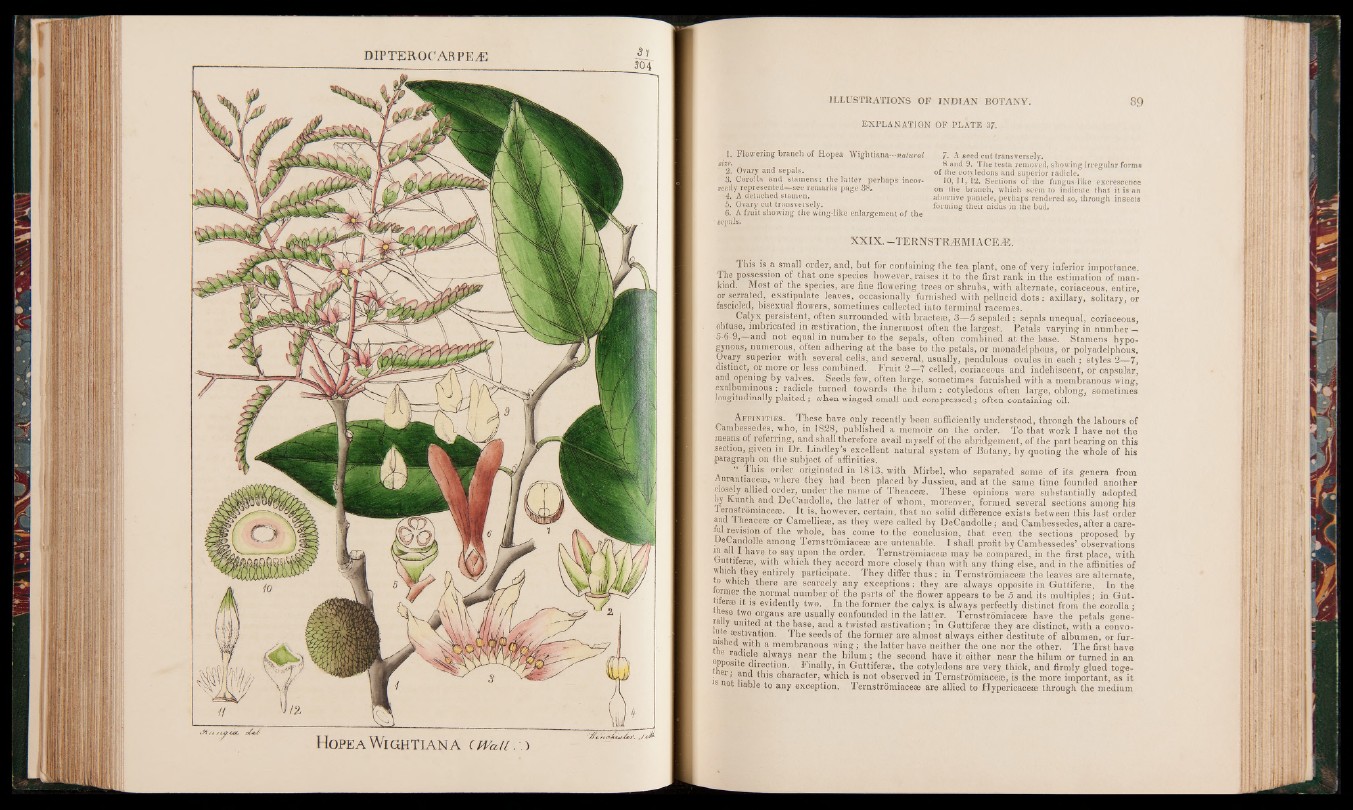
EXPLANATION OF PLATE 37.
1. Flowering branch of Hopea Wightiana—natural
size.
2. Ovary .and sepals.
3. Corolla and stamens: the latter perhaps incorrectly
represented—see remarks page 38.
4. A detached stamen.
5. Ovary Cut transversely.
6. A fruit showing the wing-like enlargement of the
sepals.
7. A seed cut transversely.
8 and 9. The testa removed, showing irregular forms
of the cotyledons and superior radicle.
10, II, 12. Sections of the fungus-like excrescence
on the branch, which seem to indicate that it is an
abortive panicle, perhaps rendered so, through insects
forming their nidus in the bud.
X X IX .—TERNSTRÆMIACEÆ.
This is a small order, and, but for containing the tea plant, one of very inferior importance.
The possession of that one species however, raises it to the.first rank in the estimation of mankind.
Most of the species, are fine flowering trees or shrubs, with alternate, coriaceous, entire,
or serrated, exstipulate leaves, occasionally furnished with pellucid dots: axillary, solitary, or
fascicled, bisexual flowers, sometimes collected into terminal racemes.
Calyx persistent, often surrounded with bracte®, 3—5 sepaled; sepals unequal, coriaceous,
obtuse, imbricated in aestivation, the innermost often the largest. Petals varying in number —
5-6-9, and not equal in number to the sepals, often combined at the base. Stamens hypo-
gynous, numerous, often adhering at the base to the petals, or monadelphous, or polyadelphous.
Ovary superior with several cells, and several, usually, pendulous ovules in each; styles 2—7,
distinct, or more or less combined. Fruit 2—7 celled, coriaceous and indehiscent, or capsular,
and opening by valves. Seeds few, often large, sometimes furnished with a membranous wing,
exalbuminous : radicle turned I towards the hilum : cotyledons often large, oblong, sometimes
longitudinally plaited; when winged small and compressed; often containing oil.
Aff in it ie s . These have only recently been sufficiently understood, through the labours of
Cambessedes, who, in 1828, published a memoir on the order. To that work I have not the
means of referring, and shall therefore avail myself of the abridgement, of the part bearing on this
section, given in Dr. Lindley’s excellent natural system of Botany, by quoting the whole of his
paragraph on the subject of affinities.
I his order originated in 1813, with Mirbel, who separated some of its genera from
in antiace®, where they had been placed by Jussieu, and at the same time founded another
closely allied order, under the name of Theace®. These opinions were substantially adopted
by Kunth and De Candolle, the latter of whom, moreover, formed several sections among his
w is, however, certain, that no solid difference exists between this last order
and 1 heace® or Camellie®, as they were called by DeCandolle; and Cambessedes, after a care-
mi revision of the whole, has come to,the conclusion, that even the sections proposed by
DeCandolle among Terns from iacese are untenable. I shall profit by Cambessedes’ observations
p a . have to say upon the order. Ternstrqmiace® may be compared, in the first place, with
with which they accord more closely than with any thing else, and in the affinities of
| IGi*,they entirely participate. They differ thus: in Ternstromiace® the leaves are alternate,
o which there are scarcely any exceptions ; they are always opposite in Guttiferae. In the
former the normal number of the parts of the flower appears to be 5 and its multiples; in Gutter
® it is evidently two. In the former the calyx is always perfectly distinct from the corolla;
inese two organs are usually confounded in the latter. Ternstromiace® have the petals gene-
,a y united at the base, and a twisted ®stivation; *n Guttifer® they are distinct, with a convo-
l- ? estivation. The seeds of the former are almost always either destitute of albumen, or fur-
msned with a membranous wing; the latter have neither the one nor the other. The first have
e ^dicle always near the hilum; the second have it either near the hilum or turned in an
PPosite direction. Finally, in Guttifer®, the cotyledons are very thick, and firmly glued toge-
^ and this character, which is not observed in Ternstromiace®, is the more important, as it
no liable to any exception. Ternstromiace® are allied to Hypericace® through the medium